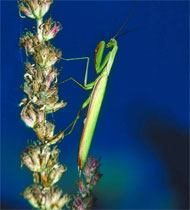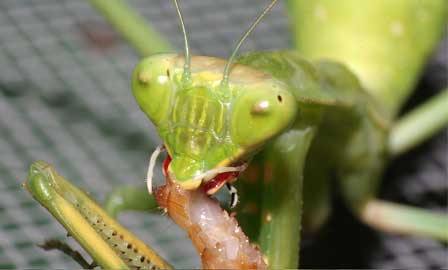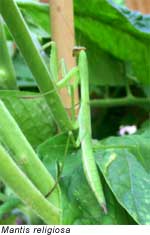|
 Variety & Location: There are approximately 2,300 species in the order Mantodea world-wide; most are tropical or subtropical, but several species live in temperate climates such as that of the northern United States, central Europe, and Siberia. Most Praying mantids are of the family Mantidae. Variety & Location: There are approximately 2,300 species in the order Mantodea world-wide; most are tropical or subtropical, but several species live in temperate climates such as that of the northern United States, central Europe, and Siberia. Most Praying mantids are of the family Mantidae.
Head-turners: Praying mantids are one of the few insects that can turn their heads. Some texts refer to the European mantis (Mantis religiosa) as the most common praying mantis in European countries. Ischnomantis gigas is the largest mantis with 17 cm length in the female and is found in the Sahel zone of Africa. The smallest mantis is Bolbe pygmaea, which is only 1cm long when fully grown.
Husband-eaters: An interesting behavior that has been observed in captive praying mantises: during or after mating, the female will bite the head off of the male, eating the head and sometimes the body of the male! It is thought that this could possibly be from stress, but perhaps the male does mate knowing the female may decide to literally bite his head off... and that he might serve as protein for his future children.

Sack of eggs: A female praying mantis will produce a large foam mass, called
an ootheca. This ootheca can contain up to 300 eggs, all protected
in the foam sack. These oothecae can take up to 5 months to hatch,
 some species hatching in small intervals. Hatching can take up to
5 weeks for all of the nymphs to fully emerge. Infertile oothecae
can also be produced by females which have not been mated. These
may sometimes hatch one or 2 nymphs; however, this is very unlikely. some species hatching in small intervals. Hatching can take up to
5 weeks for all of the nymphs to fully emerge. Infertile oothecae
can also be produced by females which have not been mated. These
may sometimes hatch one or 2 nymphs; however, this is very unlikely.
Some species, such as Brunneria borealis, produce oothecae through
parthenogenesis (this is where a male is not needed to produce fertile
ootheca) however, all the mantis' offspring of this sort will be
female.
All text is available under the terms
of the GNU Free Documentation License
|